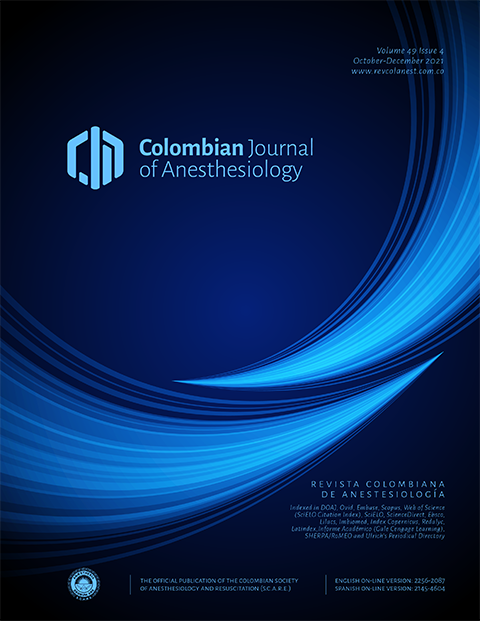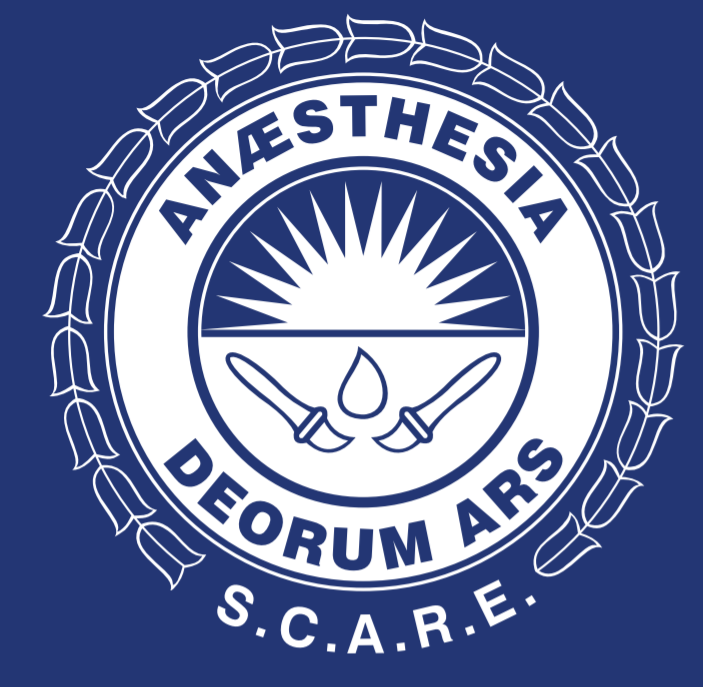Continuous erector spinae plane block at lumbar level for relief of severe pain due to hip fracture: case series
Abstract
Introduction: Hip fracture pain is frequently acute and disabling and increases perioperative complications in the patient; hence it requires a multimodal analgesia approach. This case series describes the continuous erector spinae plane block at the lumbar level for hip fracture analgesia.
Methods: A search was conducted of patients with hip fracture referred to the pain service of Hospital Universitario San Vicente Fundación (HUSVF) from August 2019 to March 2020, who had undergone continuous erector spinae plane block as part of their analgesic regimen.
Results: A total of 6 patients, 4 females and 2 males with an average age of 75 years were identified. A reduction in pain intensity from acute to mild or absent was observed in every case, up to 24 hours after the initial injection. 66 % experienced a relapse of severe pain after 24 hours and 2 patients the catheter functionality failed after 24 hours. One patient underwent dermatome pinprick assessment.
Conclusions: The continuous erector spinae plane block with a single injection provided analgesic efficacy similar to other single injection peripheral blocks, although continuous analgesia for more than 24 hours was not achieved. Some variations in the block technique described may improve the analgesic effectiveness in patients with hip fracture pain.
References
Bhandari M, Swiontkowski M. Management of acute hip fracture. N Engl J Med. 2017;377:2053-62. doi: http://doi.org/10.1056/NEJMcp1611090
Hsu JR, Mir H, Wally MK, Seymour RB. Clinical practice guidelines for pain management in acute musculoskeletal injury. J Orthopaedic Trauma. 2019;33:e158-82. doi: http://doi.org/10.1097/BOT.0000000000001430
Schug SA, Palmer GM, Scott DA, Halliwell R, Trinca J. Acute pain management: scientific evidence, fourth edition, 2015. Med J Aust. 2016;204(8):315-7. doi: http://doi.org/10.5694/mja16.00133
Adunsky A, Levy R, Mizrahi E, Arad M. Exposure to opioid analgesia in cognitively impaired and delirious elderly hip fracture patients. Arc Gerontol Geriatr. 2002;35(3):245-51. doi: http://doi.org/10.1016/s0167-4943(02)00044-4
Zhou J, Fan Y, Zhong J, Wen X, Chen X. Efficacy and safety of multimodal analgesic techniques for preventing chronic postsurgery pain under different surgical categories: a meta-analysis. Sci Rep. 2017;7: 678. doi: http://doi.org/10.1038/s41598-017-00813-5
Swift C, Chesser T, Field A, Griffiths R, Handley R, Hertz K, et al. The management of hip fracture in adults - NICE guideline. 2010;(October):27.
Brox WT, Roberts KC, Taksali S, Wright DG, Wixted JJ, Tubb CC, et al. The American Academy of Orthopaedic Surgeons evidence-based guideline on management of hip fractures in the elderly. J Bone Joint Surg Am. 2015;97(14):1196-9. doi: http://doi.org/10.2106/JBJS.O.00229
Gerhardt M, Johnson K, Atkinson R, Snow B, Shaw C, Brown A, et al. Characterisation and classification of the neural anatomy in the human hip joint. HIP International. 2012;22(1):75-81. doi: http://doi.org/10.5301/HIP.2012.9042
Short AJ, Barnett JJG, Gofeld M, Baig E, Lam K, Agur AMR, et al. Anatomic study of innervation of the anterior hip capsule implication for image-guided intervention. Reg Anesth Pain Med. 2018;43:186-92. doi: http://doi.org/10.1097/AAP.0000000000000701
Narinder R. Epidural technique for postoperative pain: gold standard no more? Reg Anesth Pain Med. 2012;37(3):310-7. doi: http://doi.org/10.1097/AAP.0b013e31825735c6
Chou R, Gordon DB, De Leon-Casasola OA, Rosenberg JM, Bickler S, Brennan T, et al. Management of postoperative pain: A clinical practice guideline from the American pain society, the American society of regional anesthesia and pain medicine, and the American society of anesthesiologists’ committee on regional anesthesia, executive commi. J Pain. 2016;17(2):131-57. doi: http://doi.org/10.1016/j.jpain.2015.12.008
Abou-Setta AM, Beaupre LA, Rashiq S, Dryden D, Hamm MP, Sadowski CA, et al. Comparative effectiveness of pain management interventions for hip fracture: A systematic review. Ann Intern Med. 2011;155:234-45. doi: http://doi.org/10.7326/0003-4819-155-4-201108160-00346
Girón-Arango L, Peng P, Chin K, Brull R, Perlas A. Pericapsular nerve group (PENG) block for hip fracture. Reg Anesth Pain Med. 2018;43(8):859-63. doi: http://doi.org/10.1097/AAP.0000000000000847
Forero M, Adhikary SD, López H, Tsui C, Chin KJ. The erector spinae plane block a novel analgesic technique in thoracic neuropathic pain. Reg Anesth Pain Med. 2016;41(5):621-7. doi: http://doi.org/10.1097/AAP.0000000000000451
Kot P, Rodríguez P, Granell M, Cano B, Rovira L, Morales J, et al. The erector spinae plane block: A narrative review. Korean J Anesthesiol. 2019;72(3):209-20. doi: http://doi.org/10.4097/kja.d.19.00012.
Tulgar S, Senturk O. Ultrasound guided erector spinae plane block at L-4 transverse process level provides effective postoperative analgesia for total hip arthroplasty. J Clin Anesth. 2017;44:68. doi: http://doi.org/10.1016/j.jclinane.2017.11.006.
Abraham A , Alabdali M, Alsulaiman A, Albulaihe H, Breiner A, Katzberget H, al. The sensitivity and specificity of the neurological examination in polyneuropathy patients with clinical and electrophysiological correlations. PLoS One. 2017;12(3):e0171597. doi: http://doi.org/10.1371/journal.pone.0171597
Tulgar S, Ermis MN, Ozer Z. Combination of lumbar erector spinae plane block and transmuscular quadratus lumborum block for surgical anaesthesia in hemiarthroplasty for femoral neck fracture. Indian J Anaesth. 2018;62:8025. doi: http://doi.org/10.4103/ija.IJA_230_18
García-Soler A, Sánchez-Iglesias I, Buiza C, Alaba J, Navarro AB, Arriola E, et al. Adaptación y validación de la versión española de la escala de evaluación de dolor en personas con demencia avanzada: PAINAD-Sp. Rev Esp Geriatr Gerontol. 2014;49(1):10-4. doi: http://doi.org/10.1016/j.regg.2013.02.001
Farrar JT, Berlin JA, Strom BL. Clinically important changes in acute pain outcome measures: a validation study. J Pain Symptom Manage. 2003;25(5):406-11. doi: http://doi.org/10.1016/s0885-3924(03)00162-3
Forero M, Rajarathinam M, Adhikary S, Chin KJ. Continuous erector spinae plane block for rescue analgesia in thoracotomy after epidural failure. A A Case Reports. 2017;8(10):254-6. doi: http://doi.org/10.1213/XAA.0000000000000478
Barrios A, Camelo J, Gómez J, Forero M, Peng P, Visbal K, et al. Evaluation of sensory mapping of erector spinae plane block. Pain Physician. 2020;23(3):E289-96.
Castillón P, Veloso M, Gómez O, Salvador J, Bartra A, Anglés F. Fascia iliaca block for pain control in hip fracture patients. Rev Esp Cir Ortop Traumatol. 2017;61(6):383-9. doi: http://doi.org/10.1016/j.recot.2017.07.004
Kukreja P, Avila A, Northern T, Dangle J, Kolli S, Kalagaraet H. A retrospective case series of pericapsular nerve group (PENG) block for primary versus revision total hip arthroplasty analgesia. Cureus. 2020;12(5):e8200. doi: http://doi.org/10.7759/cureus.8200
Tulgar S, Selvi O, Senturk O, Nurullah Ermis M, Cubuk R, Ozer Z. Clinical experiences of ultrasound-guided lumbar erector spinae plane block for hip joint and proximal femur surgeries. J Clin Anesth. 2018;47:5-6. doi: http://doi.org/10.1016/j.jclinane.2018.02.014
Bugada D, Zarcone AG, Manini M, Lorini LF. Continuous erector spinae block at lumbar level (l4) for prolonged postoperative analgesia after hip surgery. J Clin Anesth. 2019;52:24-25. doi: http://doi.org/10.1016/j.jclinane.2018.08.023
Ivanusic J, Konishi Y, Barrington MJ. A cadaveric study investigating the mechanism of action of erector spinae blockade. Reg Anesth Pain Med. 2018;43(6):567-71. doi: http://doi.org/10.1097/AAP.0000000000000789
Henderson M, Dolan J. Challenges, solutions, and advances in ultrasound-guided regional anaesthesia. BJA Educ. 2016;16(11):374-80. doi: http://doi.org/10.1093/bjaed/mkw026
Darling CE, Pun SY, Caruso TJ, Tsui BC. Successful directional thoracic erector spinae plane block after failed lumbar plexus block in hip joint and proximal femur surgery. J Clin Anesth. 2018;49:1-2. doi: http://doi.org/10.1016/j.jclinane.2018.05.002.
Downloads
| Article metrics | |
|---|---|
| Abstract views | |
| Galley vies | |
| PDF Views | |
| HTML views | |
| Other views | |














